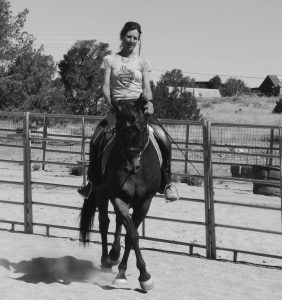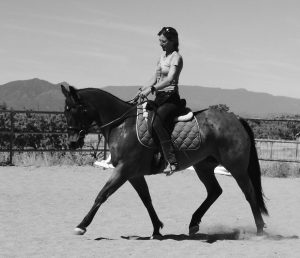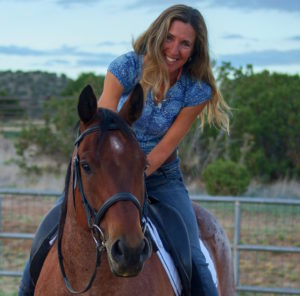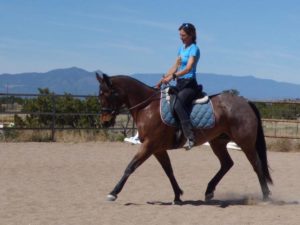 Editor’s Note: Best Horse Practices Summit presenter Katrin Silva grew up riding dressage in Germany before moving to the United States at age 19 to learn to ride Western. She’s been riding both disciplines for the last 20 years and is a regular guest columnist for Cayuse Communications. The author of Dressage for All of Us: How to Help Any Horse Become a Happier, More Responsive Riding Partner lives in New Mexico where she works with dressage and Western clients. Visit her blog here.
Editor’s Note: Best Horse Practices Summit presenter Katrin Silva grew up riding dressage in Germany before moving to the United States at age 19 to learn to ride Western. She’s been riding both disciplines for the last 20 years and is a regular guest columnist for Cayuse Communications. The author of Dressage for All of Us: How to Help Any Horse Become a Happier, More Responsive Riding Partner lives in New Mexico where she works with dressage and Western clients. Visit her blog here.
This is a two-part column. Read Part I for the first five signs.
Silva writes:
The road to a well-trained horse – a dressage horse, a western horse, or any other horse – is not a single, clearly-marked path. It’s a maze, paved with good intentions and confusion. Signs contradict each other. Here are the remaining five ways to tell whether your training is going in a good direction.
 You are not physically tired every time you get off your horse.
You are not physically tired every time you get off your horse.
It is true that good riders need to be athletic, but riding horses should not be a strength workout. If your arms are tired after your ride, it means your contact was too strong. If your legs are tired, you are squeezing or nagging too much, instead of teaching your horse to respond to a light leg aid. If your core muscles get tired, you might be constantly pushing or driving, instead of using your seat in a meaningful way. You should also not suffer from emotional fatigue from frequently arguing or fighting. Training a horse means building a partnership. As your horse learns to understand the language of your back and vice versa, he will become more responsive – to the rein, to the leg, to the seat, to your voice. Riding should become less of a physical effort for you as your horse progresses.
- Your horse’s gaits become more beautiful to look at and easier to sit.
As the horse learns to balance himself under his rider, his movement becomes more cadenced, more rhythmic. His topline develops. His back starts to swing, inviting your back to engage with it. You start talking to each other. If his trot feels like it will rattle the fillings from your teeth, then his back is too tense for meaningful conversation.
- Your horse looks happy most of the time.
 He does not habitually swish his tail, pin his ears, or grind his teeth. His eyes are soft. His facial muscles are relaxed. His breathing is regular and deep. Any moments of disagreement or tension are just that – moments. They don’t last an entire ride, nor do they occur during most of your rides.
He does not habitually swish his tail, pin his ears, or grind his teeth. His eyes are soft. His facial muscles are relaxed. His breathing is regular and deep. Any moments of disagreement or tension are just that – moments. They don’t last an entire ride, nor do they occur during most of your rides.
- You don’t feel like you are riding two completely different horses depending on which way you are going.
With correct training, your horse’s left and right side will feel more similar. His stiff side becomes easier to bend, his hollow side becomes straighter and stronger. When what used to be the stiff side becomes the hollow side, I know my horse is on his way to becoming a true athlete. When I can’t remember which side was hollow to begin with, I know I’ve done my job right.
- Your horse’s comfort zone becomes larger.

Katrin Silva rides with correct contact
It’s easier (and safer) to work with green or troubled horses in a controlled, consistent, confined environment. I use a round pen first, then a small arena. Once your horse has learned basic skills, this comfort zone needs to expand. As your training progresses, your horse learns to focus on his work. Distractions like barking dogs, plastic bags, or moving tractors become less of an issue. Novel situations become more manageable. You can ride trails. You can take your horse to another arena, or a show, or clinic. You can play around with obstacles or cavalletti. Your horse is game for trying new things because his comfort zone is wherever you are.
If your training is going in the right direction, congratulations!
If you’ve got work to do in a few of these areas, welcome to the club. Building a partnership with a horse is a long process, a wandering, meandering journey through a jungle of methods and approaches. There are many ways to train a horse. I hope these guideposts help you find the common ground between them. I hope they show you a path that works for you and equine partner.
Love these last 5 indications your training is on the right path!
Excellent. So true Part I and II. Thanks! K